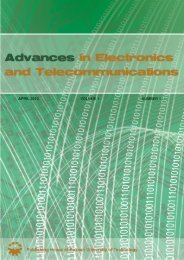november 2010 volume 1 number 2 - Advances in Electronics and ...
november 2010 volume 1 number 2 - Advances in Electronics and ...
november 2010 volume 1 number 2 - Advances in Electronics and ...
Create successful ePaper yourself
Turn your PDF publications into a flip-book with our unique Google optimized e-Paper software.
56 ADVANCES IN ELECTRONICS AND TELECOMMUNICATIONS, VOL. 1, NO. 2, NOVEMBER <strong>2010</strong><br />
Fig. 1. Systematic feedback convolutional encoder over r<strong>in</strong>g of <strong>in</strong>tegers modulo-M.<br />
Vt = UtG (3)<br />
where G denotes the generator matrix of the encoder [8].<br />
The state of the encoder at time t is determ<strong>in</strong>ed by the<br />
content of memory elements<br />
Xt = (x (1)<br />
t , x (2)<br />
t , ..., x (m)<br />
t ) T , (4)<br />
where m is the <strong>number</strong> of encoder memory elements.<br />
In case of packet transmission without tail, where the<br />
convolutional encoders with feedback are utilized, we have<br />
to calculate the <strong>in</strong>itial state X0 that must be the same as the<br />
f<strong>in</strong>d state XN of the encoder after N cycles. This is not quite<br />
easy. To f<strong>in</strong>d this start<strong>in</strong>g state, we used the method proposed<br />
<strong>in</strong> [8]. The correct start<strong>in</strong>g state can by calculated us<strong>in</strong>g the<br />
state space representation. The state of the encoder <strong>in</strong> time<br />
t + 1 can be described as:<br />
Xt+1 = AXt + BU T t<br />
, (5)<br />
where A is the (m × m) state matrix which def<strong>in</strong>es connections<br />
between memory elements, B is the (m × k) control<br />
matrix which def<strong>in</strong>es connections between encoder <strong>in</strong>puts <strong>and</strong><br />
memory elements.<br />
The vector Vt at the encoder output <strong>in</strong> time t can be<br />
described as <strong>in</strong> [8]:<br />
V T<br />
t = CXt + DU T t , (6)<br />
where: C is the (n × m) observation matrix which def<strong>in</strong>es<br />
connections between encoder outputs <strong>and</strong> memory elements,<br />
D is the (n × k) transition matrix which def<strong>in</strong>es connections<br />
between encoder entries <strong>and</strong> outputs.<br />
In the paper [8] it was also shown that the state (Xt) <strong>in</strong><br />
time t, of the systematic convolutional encoder with feedback<br />
can be described as the superposition of two vectors X [zi]<br />
t <strong>and</strong><br />
which def<strong>in</strong>e the end<strong>in</strong>g state of the encoder<br />
X [zs]<br />
t<br />
where X [zi]<br />
t<br />
Xt = X [zi]<br />
t<br />
+ X[zs] t<br />
is the vector which def<strong>in</strong>es the encoder state<br />
achieved after t cycles if the encod<strong>in</strong>g process started <strong>in</strong> state<br />
(7)<br />
X0 <strong>and</strong> all <strong>in</strong>puts symbols are zero, X [zs]<br />
t<br />
is the vector which<br />
def<strong>in</strong>estheencoderstateachievedafter tcyclesiftheencod<strong>in</strong>g<br />
stared <strong>in</strong> the all zero state (X0 = 0) <strong>and</strong> the <strong>in</strong>formation<br />
symbol sequence is encoded.<br />
From the equations (5) <strong>and</strong> (7) we can write that:<br />
Xt = X [zi]<br />
t<br />
+ X [zs]<br />
t<br />
�<br />
= A t t−1<br />
X0 + A (t−1)−τ BU T τ . (8)<br />
τ =0<br />
If we assume that the state <strong>in</strong> time t = N is equal to the <strong>in</strong>itial<br />
state X0, we obta<strong>in</strong> from (8):<br />
(Im − A N )X0 = X [zs]<br />
N , (9)<br />
Thisequationcanbewrittenforconvolutionalencodersover<br />
r<strong>in</strong>g ℜ = ZM as:<br />
(Im + A N )X0 = X [zs]<br />
N , (10)<br />
where Im is the (m × m) identity matrix. As it is seen<br />
from (10), we can calculate the correct <strong>in</strong>itial state X0 of the<br />
encoder if the matrix (Im + AN ) is <strong>in</strong>vertible.<br />
The matrix A from equation (10) for the systematic convolutional<br />
encoder with feedback is described as [8], [9]:<br />
⎡<br />
⎢<br />
A = ⎢<br />
⎣<br />
0 · · · 0<br />
1<br />
. ..<br />
1<br />
�<br />
�<br />
�<br />
�<br />
�<br />
�<br />
�<br />
�<br />
�<br />
fm<br />
fm−1<br />
.<br />
.<br />
f1<br />
⎤<br />
⎥<br />
⎦<br />
(11)<br />
Us<strong>in</strong>g the mathematical relations (9) <strong>and</strong> (10), obta<strong>in</strong>ed above<br />
we can describe the encod<strong>in</strong>g process for TBR codes as<br />
follows: at first, we have to calculate the vector X [zs]<br />
N for a<br />
given <strong>in</strong>formation data packet. Accord<strong>in</strong>gly, the encoder starts<br />
<strong>in</strong> the all zero state. All the N · k <strong>in</strong>formation symbols are<br />
encoded but the output symbols are ignored. After N cycles<br />
the encoder will be <strong>in</strong> the state X [zs]<br />
N . Then, form (10) we can<br />
calculate the correct <strong>in</strong>itial state X0, the encoder can start the<br />
proper encod<strong>in</strong>g process <strong>and</strong> a valid codeword results. After<br />
N cycles the encoder ends its work, reaches the state which<br />
is the same as its start<strong>in</strong>g state.







